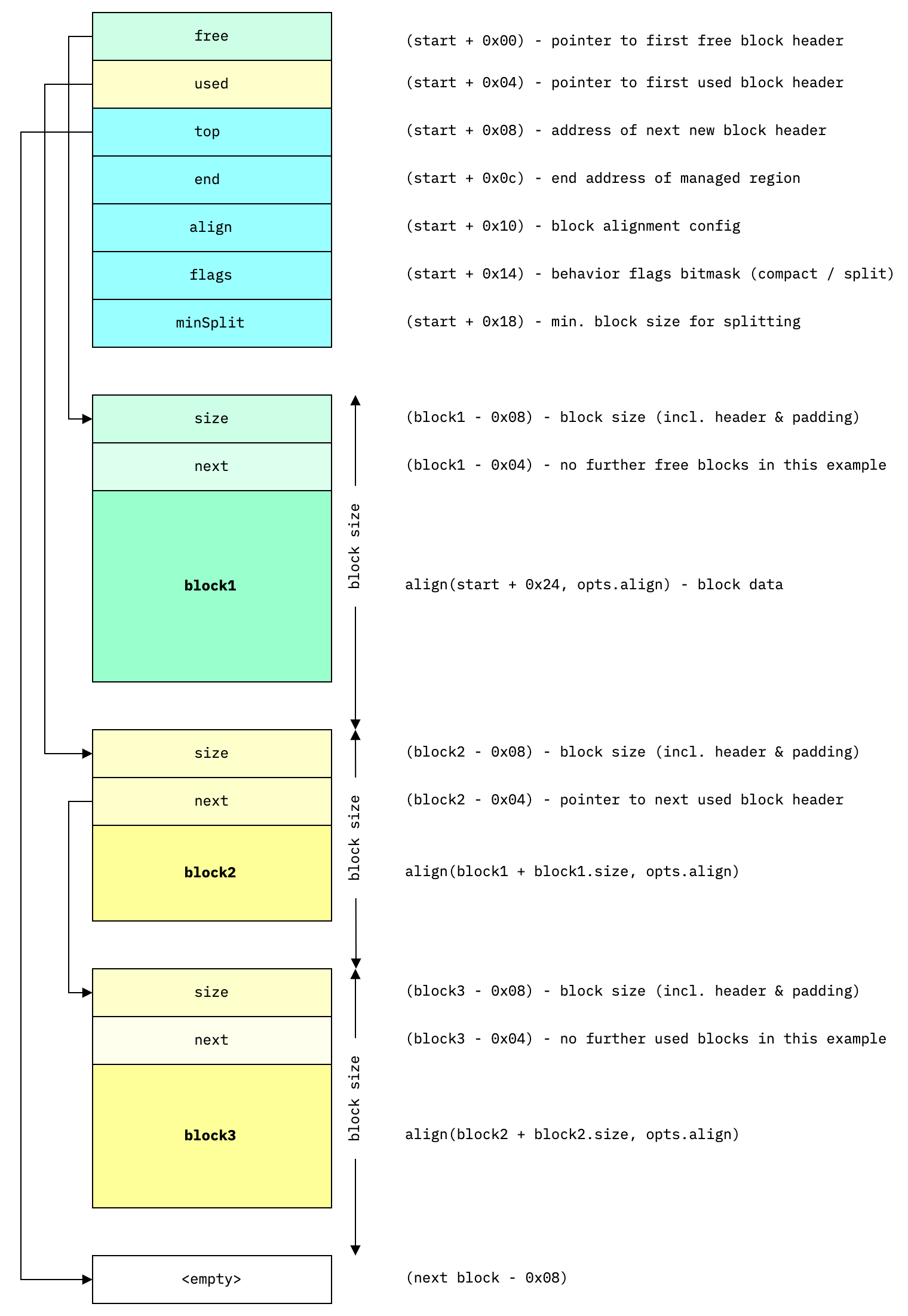Note
This is one of 199 standalone projects, maintained as part of the @thi.ng/umbrella monorepo and anti-framework.
🚀 Please help me to work full-time on these projects by sponsoring me on GitHub. Thank you! ❤️
ArrayBuffer based malloc() impl for hybrid JS/WASM use cases, based on thi.ng/tinyalloc.
Supports free block compaction and configurable splitting. Unlike the
original, this implementation also supports realloc() and does not
constrain the overall number of blocks in use and the only imposed limit
is that of the underlying array buffer.
Each MemPool instance operates on a single large ArrayBuffer used as
backing memory chunk, e.g. the same buffer used by a WASM module.
Even for non-WASM use cases, using this package can drastically speed up allocation of typed arrays and reduce GC pressure. See benchmarks below.
Since v4.1.0, all internal allocator state is stored in the
ArrayBuffer itself (thanks to the initial idea & work done by
@Bnaya). This change
allows the ArrayBuffer (or SharedArrayBuffer) being passed to
workers and/or the entire memory state being easily serialized/restored
to/from local storage.
The new memory layout is as follows:
The allocator supports coalescing of free memory blocks to minimize fragmentation of the managed address space. This feature is enabled by default, but can be disabled via config options.
The following diagrams show the different stages of this behavior:
Initial layout
In this example we start with three allocated neighboring blocks:
Non-continuous free blocks
After freeing the first & last blocks, the free blocks are linked via
their next pointers, but still occupy non-continuous memory regions.
Single compacted free block
After also freeing block #2, all three blocks now span a single
continuous address range and are merged into a single larger free block.
Furthermore, if that resulting new block turns out to be the top-most
block (in terms of previously allocated address space), the allocator
does not create a free block at all, but merely resets its heap top
pointer to the beginning of that block and considers it blank space that
way (essentially a merge with the remaining free/unallocated space of
the array buffer).
In order to avoid unnecessary growing of the heap top, the allocator
can split existing free blocks if the user requests allocating a smaller
size than that of a suitable free block available. If the free block has
sufficient excess space (configurable via the minSplit option), the
free block will be split, the lower part marked as allocated and
inserted into the used block list and the excess space inserted as new
free block back into the free list.
This behavior too is enabled by default, but can be turned off via the
split config option.
Initial example layout:
Layout after allocating only a smaller size than the free block's capacity:
STABLE - used in production
Search or submit any issues for this package
yarn add @thi.ng/mallocESM import:
import * as m from "@thi.ng/malloc";Browser ESM import:
<script type="module" src="https://esm.run/@thi.ng/malloc"></script>For Node.js REPL:
const m = await import("@thi.ng/malloc");Package sizes (brotli'd, pre-treeshake): ESM: 1.81 KB
Note: @thi.ng/api is in most cases a type-only import (not used at runtime)
One project in this repo's /examples directory is using this package:
| Screenshot | Description | Live demo | Source |
|---|---|---|---|
 |
Fitting, transforming & plotting 10k data points per frame using SIMD | Demo | Source |
The MemPool constructor takes an object of optional configuration options. See
MemPoolOpts
for further reference:
import { Type } from "@thi.ng/api";
import { MemPool } from "@thi.ng/malloc";
// example with some default options shown
new MemPool({
size: 0x1000,
compact: true,
split: true,
minSplit: 16
});
// create memory w/ optional start allocation address
// (start address can't be zero, reserved for malloc/calloc failure)
const pool = new MemPool({ size: 0x1000, start: 8 });
// all memory blocks will be aligned to 8-byte boundaries
// size is given in bytes
// returns pointer / index in array buffer
ptr = pool.malloc(16);
// 8
// request memory and return as typed array view
// in this case we use number of elements, NOT bytes
// IMPORTANT: there's no guarantee that the returned array's
// values are zeroed. Use `calloc`/`callocAs` for that purpose
vec = pool.mallocAs(Type.F64, 4);
// Float64Array [ 0, 0, 0, 0 ]
// report block stats (sizes & addresses in bytes)
pool.stats();
// { free: { count: 0, size: 0 },
// used: { count: 2, size: 48 },
// top: 56,
// available: 4040,
// total: 4096 }
// reallocate/resize block for pointer/address
// (might move block contents to new mem region)
ptr = pool.realloc(ptr, 32);
// same but for arrays created with `mallocAs()`
vec = pool.reallocArray(vec, 5);
// release address or view back into pool / heap
pool.free(ptr);
// true
pool.free(vec);
// true
// pointers / views can only be freed once
pool.free(vec);
// false
// memory blocks are re-merged whenever possible
// likewise, available free blocks might be split
// if smaller size requested...
pool.stats();
// { free: { count: 1, size: 48 },
// used: { count: 0, size: 0 },
// top: 56,
// available: 4040,
// total: 4096 }Attempts to allocate a new block of memory of given byte size and
returns start address if successful, or zero (0) if unsuccessful.
Memory blocks always start at multiples of the configured alignment
(default: 8).
Similar to malloc(), but returns a typed array view of desired type
and instead of byte size, expects number of elements. Returns null, if
allocation failed.
Types are referred to via the Type enum in the base
@thi.ng/api
package, e.g. Type.F64:
U8, U8C, I8, U16, I16, U32, I32, F32, F64
Like malloc() but fill allocated block with given fill value before
returning. Unless the allocated block is immediately filled with user
data, this method is preferred over malloc() for safety.
Like mallocAs() but fills allocated block with fill value before
returning.
Attempts to adjust the size of the block at the given allocated address
to new size or if not possible, attempt to allocate a new block and
copies contents of current block (if successful, automatically frees old
address). Returns new address if successful or else 0.
Similar to realloc(), but takes a typed array created with
mallocAs() / callocAs() and returns new arrays of same type or
null if re-allocation wasn't possible.
Releases given address or array view back into the pool. Returns true
if successful. Only previously allocated addresses or views created by
this instance can be freed and its the user's responsibility to not use
the freed address or view after this call.
Frees all allocated blocks, essentially resets the pool. This is useful
when using a MemPool for temporary object allocation within a function
and then calling this method before returning. This is also much cheaper
than individually freeing the blocks.
This completely destroys all internal pool references & state and should
only be used when the pool is no longer needed. The pool is unusable
afterwards. If there're no other external references to the pool's
underlying ArrayBuffer, then it will also be garbage collected soon
after.
Returns pool statistics (see above example).
The NativePool class provides a stub/polyfill implementation of the
IMemPoolAs interface and is merely delegating to JS-native typed array ctors
with no further management of the returned arrays.
import { NativePool } from "@thi.ng/malloc";
const pool = new NativePool();
const a = pool.mallocAs(Type.F32, 4);
// Float32Array [ 0, 0, 0, 0 ]
const a2 = pool.callocAs(Type.F32, 4, 1);
// Float32Array [ 1, 1, 1, 1 ]
const b = pool.reallocArray(a2, 8);
// Float32Array [ 1, 1, 1, 1, 0, 0, 0, 0 ]Benchmark (source) comparing against raw typed array construction of different sizes:
node bench/index.jsmalloc_f64x4 x 3,317,667 ops/sec ±0.61% (93 runs sampled) mean: 0.00030ms**
malloc_f64x4_vanilla x 4,221,089 ops/sec ±0.32% (94 runs sampled) mean: 0.00024ms
malloc6_f64 x 358,405 ops/sec ±0.37% (90 runs sampled) mean: 0.00279ms
malloc6_f64_vanilla x 283,487 ops/sec ±0.81% (90 runs sampled) mean: 0.00353ms
malloc_f32x1024 x 13,700,920 ops/sec ±0.38% (96 runs sampled) mean: 0.00007ms
malloc_f32x1024_vanilla x 694,747 ops/sec ±2.11% (78 runs sampled) mean: 0.00144ms
In this micro benchmark, allocating 4KB blocks (1024 floats) is ~20x
faster than calling new Float32Array(1024). On the other hand,
allocating tiny arrays is slightly slower than the vanilla version... YMMV!
- Karsten Schmidt (Main author)
- Bnaya Peretz
If this project contributes to an academic publication, please cite it as:
@misc{thing-malloc,
title = "@thi.ng/malloc",
author = "Karsten Schmidt and others",
note = "https://thi.ng/malloc",
year = 2016
}© 2016 - 2024 Karsten Schmidt // Apache License 2.0









